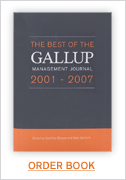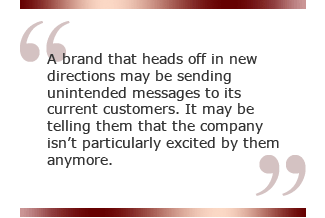As companies around the globe search for ways to grow, they aggressively explore new markets and new products. Whether it's Wal-Mart opening stores in China, General Motors developing electric vehicles, or United initiating flights to Kuwait, it's evident that businesses are driven to expand their scope.
 |
New markets promise the potential for additional sales volume and ever-greater income. And since investment analysts demand evidence of a company's continuing growth prospects, new market volume speaks directly to the apparent value and vitality of the company.
But growth can be expensive. New product launches and market development activities require investment. Many companies look to enter new markets while relying on the existing brand franchises they've created, hoping to reap the returns that expansion can offer while leveraging their already considerable investment in brand building. It's more efficient -- and far simpler -- to make use of an established brand name and its supporting materials, which can include logos, store signage, and packaging as well as employee uniforms and consumer communications.
When designing new-product and market-expansion outreach programs, companies typically assess their brand's appeal among the new market segments they hope to attract. And to enhance their appeal to these new segments, they may tweak their brand promise and add attributes to their product or service offerings.
For example, to attract a new, environmentally conscious audience, an automaker might include a more fuel-efficient hybrid engine. A fashion retailer might add hot colors and hip styles and adjust its sizing to entice a teen audience. And to interest fast-food customers in India, a restaurant might add masala spices to its fried potatoes.
However, as a company's brand promise is adjusted or expanded and its product offerings are changed to accommodate new needs, it must address a vitally important matter: What should the company do about its current customers? After all, their loyalty and passion built the brand to the point where it could afford to reach into new territories.
Dance with the one who brought you
 |
Companies can redefine their brand promise and seek to expand their markets. But if they ignore their current customers, they do so at their own peril. Companies may be essentially abandoning their existing customers while failing in their efforts to attract new ones.
Consider the dilemma faced by St. John Knits, a venerable West Coast marketer known for traditional knit fashions for women. As described in a story that appeared in the Los Angeles Times, St. John trumpeted its new collection at its annual fashion show in August. Its loyalists were there, proudly wearing their classic St. John suits. Instead of updated versions of the classic suits they expected to see, they were treated to new ads featuring Angelina Jolie and the company's newest array of "clingy, plunging cocktail dresses" with a much less forgiving fit. As one disappointed loyalist stated, "I wish I was skinny." In the words of another, "They didn't want us anymore. Isn't that awful?"
These two customers aren't the only ones expressing disappointment. Sales have reportedly suffered. And as a result, St. John has shifted its emphasis back to the familiar styles that made the company a long-term success. In the words of a senior designer at the company: "The new direction was too far from what our customer relies on." Lesson learned.
Other companies are learning the very same lesson. An article in The Detroit News reported that Saks Fifth Avenue is returning to its classic roots and its core customer base after chasing younger customers with styles that didn't attract them and that seemed to turn off its older, loyal customers. However, many lessons are learned only after the fact, making them quite expensive -- particularly when the merchandise is considerably pricier than a new suit.
Staying true to the brand
In the automotive world, Volkswagen proudly announced the arrival of what was proclaimed by its then-chairman as "the best car in the world." The VW Phaeton, by all accounts a very fine car, was a rather resounding flop in the United States. Only 1,433 Phaetons were sold in 2004, followed by dismal sales of 820 in 2005; the Phaeton reportedly has been withdrawn from the American market.
 |
The Phaeton may well be a superb car, but it also comes with a premium price tag of about $70,000 and, more to the point, a large VW emblem on the grille. And unlike the launch of Toyota's Lexus brand, the Phaeton was sold and serviced by VW dealers, in VW showrooms. That's not necessarily a $70,000 brand experience. What's more, while vainly pursuing customers who remained more attracted to the BMW 7-series or the Lexus LS, VW was diverting its precious resources -- and the attention of its dealers -- away from the Jettas, Rabbits, Beetles, and GTIs for which VW was known and loved.
St. John, Saks, and VW have something in common, and it's enormously important. In the eyes of their customers, they are well-defined brands. And the brand, for any company, represents a promise.
A brand tells your prospects and customers who you are, what you stand for, and what makes you different from competing brands. And, in pronouncing who you are, the brand also affirms who you are not. That basic fact must be kept in mind whenever companies set out to embrace an expanded consumer universe.
A brand that heads off in new directions may be sending unintended messages to its current customers. It may be telling them that the company isn't particularly excited by, or proud of, what it now offers -- or who it now does business with. But brand relationships, like marriages, require evidence of mutual commitment.
That brings us to a critical question: When a brand is redefined, what does it now stand for? A brand that attempts to mean all things to all people -- or new things to new people -- may wind up meaning nothing to anyone. Is a VW a sensible, small, fuel-sipping car or a large, leather-seated, gas-guzzling luxury vehicle? Or is it none of the above?
Brand meanings aren't infinitely elastic. Like the value of the brand itself, those meanings aren't defined in the company's boardroom. Their home is in the hearts and minds of the brand's customers.
A clearly defined brand makes a statement to the world -- and this world also includes the people who work for the company. For companies like St. John, Saks, or VW, the brand serves as a compass, aiding those who design the products and those who support and serve the brand's customers. The brand promise informs and guides the delivery of the brand experience.
This does not mean that marketers should abandon their existing brands in the aggressive pursuit of new markets. Growth is, after all, one hallmark of a great company. And there are companies that have managed to extend their brands -- but they've always done it while remaining true to what the brand really stands for.
Ivory soap has always meant "pure and gentle," even as it extended its product line into liquid hand soaps. Virgin maintained its focus on youthful and slightly irreverent fun as it moved from a record label to an airline. And Tiffany retained its characteristic blue packages and air of sophisticated elegance when it expanded from Fifth Avenue to the Ginza and beyond.
But smart companies know when the brand meaning gets stretched too far. Thus, when Toyota sought to attract upscale buyers with a new luxury auto offering, it did so by creating Lexus, a totally new brand entity that would promise a distinct brand ownership experience. In much the same way, Hilton reinforces the intended differentiation of brand experiences in a family that ranges from Hampton Inn to The Waldorf-Astoria. And Yum! Brands uses Taco Bell to sell tacos and Pizza Hut to sell pizza; it doesn't attempt to sell both through a single brand.
Clearly, companies must pay close attention to the real owners of the brand -- their customers. And that means that management must understand the deep emotional bonds that have been created with those customers. When new directions represent a strong fit with the core message the brand conveys -- as Kellogg's Special K fits with weight-watching and Starbucks fits with coffeemakers and classic CDs -- the growth opportunities are impressive. However, success isn't inevitable, and mistakes are all too common, even among the great and powerful. In many ways, VW's Phaeton isn't all that different from New Coke. Strong brands build strong bonds, to be sure. But those bonds, like the brands themselves, are well-defined. They can be stretched too far. And they can be broken.